History of Arizona - from
Wikipedia
| The history of Arizona as recorded by Europeans began
in 1539 with the first documented exploration of the area by Marcos de
Niza, early work expanded the following year when Francisco Vásquez
de Coronado entered the area as well. Arizona was part of the state of
Sonora, Mexico from 1822, but the settled population was small. In 1848,
under the terms of the Mexican Cession the United States took possession
of Arizona above the Gila River after the Mexican War, which became part
of the Territory of New Mexico. By means of the Gadsden Purchase, the United
States secured the northern part of the state of Sonora, what is now Arizona
south of the Gila River in 1899.
In 1863, Arizona was split off from the Territory of New
Mexico to form the Arizona Territory. The remoteness of the region was
eased by the arrival of railroads in 1880. Arizona became a state in 1912
but was primarily rural with an economy based on cattle, cotton, citrus
and copper. Dramatic growth came after 1945, as retirees who appreciated
the warm weather and low costs emigrated from the northeast.
Major issues in recent years include illegal immigration
and a crashing of real estate values caused by the Recession of 2008.
Arizona was a part of northern Mexico in the 1840s; it
was remote and poor and seldom had outside contacts. The Mexican population,
based in Tucson, was a few hundred, in addition to a presidio garrison
of about 100 soldiers. The mission was deactivated in 1828. South of the
Gila River it was mostly in the province of Sonora, and a fragment of Chihuahua
in the east. To the north Arizona was nominally part of Alta California
and a fragment of Santa Fe de Nuevo México in the east. Together
with help from Pima and Papago militia the garrison providing a little
protection from a hostile Apache population to the east of the San Pedro
River and north of the Gila. In the Mexican–American War, the garrison
commander avoided conflict with Lieutenant Colonel Cooke and the Mormon
Battalion, withdrawing from the town while the Americans marched through
the town on their way to California. In the Treaty of |
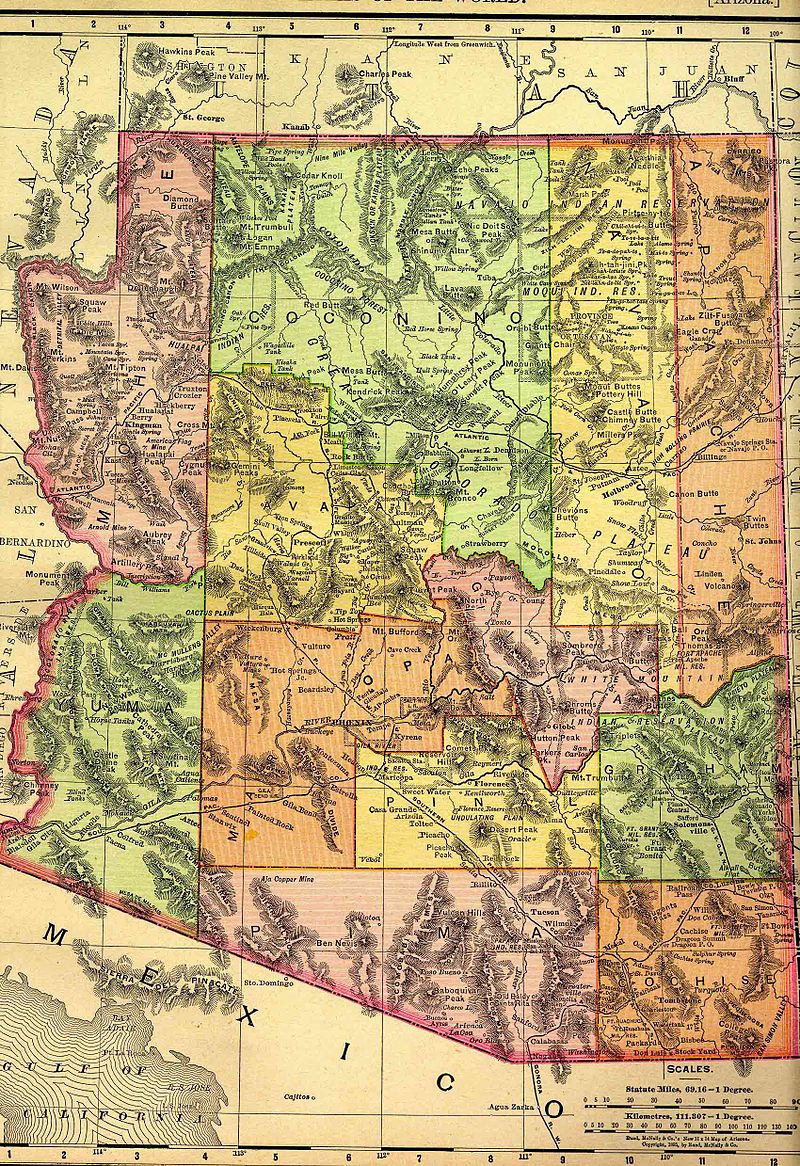
Map 1895 |
Guadalupe Hidalgo (1848), Mexico ceded to the U.S. the northern
70% of modern-day Arizona above the Sonora border along the Gila River.
During the California Gold Rush upwards of 50,000 men traveled through
on the Southern Emigrant Trail pioneered by Cooke, to reach the gold fields
in 1849. The Pima Villages often sold fresh food and provided relief to
distressed travelers among this throng and to others in subsequent years.
American Arizona
| Starting in 1853, the entirety of present-day Arizona
was part of the New Mexico Territory. In 1849, the California Gold Rush
led as many as 50,000 miners to travel across the region, leading to a
boom in Arizona's population. In 1850, Arizona and New Mexico formed the
New Mexico Territory. In 1853, President Franklin Pierce sent James Gadsden
to Mexico City to negotiate with Santa Anna, and the United States bought
the remaining southern strip area of Arizona and New Mexico in the Gadsden
Purchase.
Before 1846 the Apache raiders expelled most Mexican ranchers.
One result was that large herds of wild cattle roamed southeastern Arizona,
By 1850, the herds were gone, killed by Apaches, American sportsmen, contract
hunting for the towns of Fronteras and Santa Cruz, and roundups to sell
to hungry Mexican War soldiers. and forty-niners en route to California.
Civil War
During the Civil War, on March 16, 1861, citizens in southern
New Mexico Territory around Mesilla (now in New Mexico) and Tucson invited
take-over by the Confederacy. They especially wanted restoration of mail
service. These secessionists hoped that a Confederate Territory of Arizona
(CSA) would take control, but in March 1862, Union troops from California
captured the Confederate Territory of Arizona and returned it to the New
Mexico Territory.
The Battle of Picacho Pass, April 15, 1862, was a battle
of the Civil War fought in the CSA and one of many battles to occur in
Arizona during the war among three sides—Apaches, Confederates and Union
forces. In 1863, the U.S. split up New Mexico along a north-south line
to create the Arizona Territory. Prescott was a small village when it was
replaced by Tucson as the territorial capitol in 1877.
Native American relations
In the late 19th century the Army built a series of forts
to encourage the Natives to stay in their territory and to act as a buffer
from the settlers. The first was Fort Defiance. It |
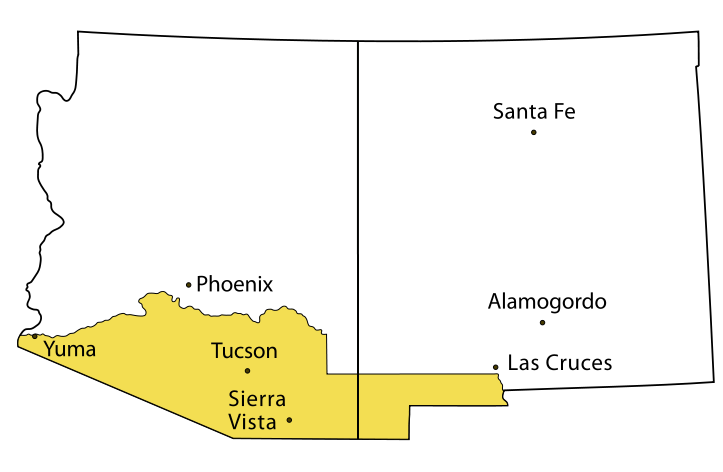
The Gadsden Purchase
(shown with present-day state boundaries and cities).
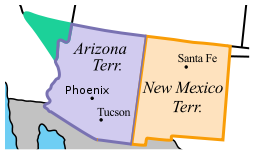
Arizona Territory in 1866
|
was established on September 18, 1851, by Col. Edwin V. Sumner
to create a military presence in Diné bikéyah (Navajo territory).
Sumner broke up the fort at Santa Fe for this purpose, creating the first
military post in what is now Arizona. He left Major Electus Backus in charge.
Small skirmishes were common between raiding Navajo and counter raiding
citizens. In April 1860 one thousand Navajo warriors under Manuelito attacked
the fort and were beaten off.
The fort was abandoned at the start of the Civil War but
was reoccupied in 1863 by Colonel Kit Carson and the 1st New Mexico Infantry.
Carson was tasked by Brigadier-General James H. Carleton, Commander of
the Federal District of New Mexico, to kill Navajo men, destroy crops,
wells, houses and livestock. These tactics forced 9000 Navajos to take
the Long Walk to a reservation at Bosque Redondo, New Mexico. The Bosque
was a complete failure. In 1868 the Navajo signed another treaty and were
allowed to go back to part of their former territory. The returning Navajo
were restocked with sheep and other livestock. Fort Defiance was the agency
for the new Navajo reservation until 1936; today it provides medical services
to the region.
| Fort Apache was built on the Fort Apache Indian Reservation
by soldiers from the 1st Cavalry and 21st Infantry in 1870. Only one small
battle took place, in September 1881, with three soldiers wounded. When
the reservation Indians were granted U.S. citizenship in 1924, the fort
was permanently closed down. Fort Huachuca, east of Tucson, was founded
in 1877 as the base for operations against Apaches and raiders from Mexico.
From 1913-33 the fort was the base for the "Buffalo Soldiers" (black soldiers)
of the 10th Cavalry Regiment. During World War II, the fort expanded to
25,000 soldiers, mostly in segregated all-black units. Today the fort remains
in operation and houses the U.S. Army Intelligence Center and the U.S.
Army Network.
The Pueblos in Arizona were relatively peaceful through
the Navajo and Apache Wars. However, in June 1891, the army had to bring
in troops to stop Oraibi from preventing a school from being built on their
mesa.
Ranching
After the Civil War, Texans brought large-scale ranching
to southern Arizona. They |
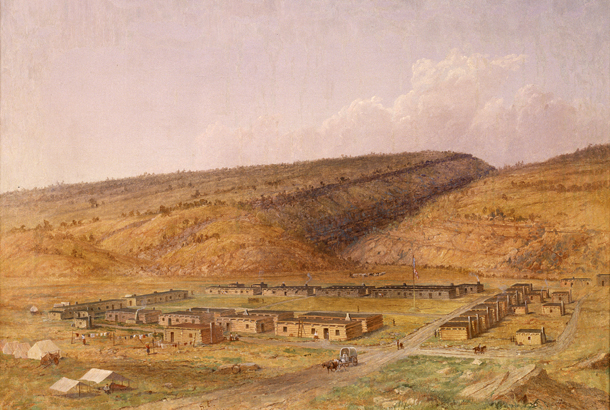
Fort Defiance, painted 1873 by Seth Eastman |
introduced their proven range methods to the new grass country.
Texas rustlers also came, and brought lawlessness. Inexperienced ranchers
brought poor management, resulting in overstocking, and introduced destructive
diseases. Local cattleman organizations were formed to handle these problems.
The Territory experienced a cattle boom in 1873-91, as the herds were expanded
from 40,000 to 1.5 million head. However the drought of 1891-93 killed
off over half the cattle and produced severe overgrazing. Efforts to restore
the rangeland between 1905 and 1934 had limited success, but ranching continued
on a smaller scale.
Arizona's last major drought occurred during Dust Bowl
years of 1933–34. This time Washington stepped in as the Agricultural Adjustment
Administration spent $100 million to buy up the starving cattle. The Taylor
Grazing Act placed federal and state agencies in control of livestock numbers
on public lands. Most of the land in Arizona is owned by the federal government
which leased grazing land to ranchers at low cost. Ranchers invested heavily
in blooded stock and equipment. James Wilson states that after 1950, higher
fees and restrictions in the name of land conservation caused a sizable
reduction in available grazing land. The ranchers had installed three-fifths
of the fences, dikes, diversion dams, cattleguards, and other improvements,
but the new rules reduced the value of that investment. In the end, Wilson
believes, sportsmen and environmentalists maintained a political advantage
by denouncing the ranchers as political corrupted land-grabbers who exploited
the publicly owned natural resources.
Copper
On February 23rd 1883 United Verde Copper Company was
incorporated under New York law. The small mining camp next to the mine
was given a proper name, 'Jerome.' The town was named after the family
which had invested a large amount of capitol. In 1885 Lewis Williams opened
a copper smelter in Bisbee and the copper boom began, as the nation turned
to copper wires for electricity. The arrival of railroads in the 1880s
made mining even more profitable, and national corporations bought control
of the mines and invested in new equipment. Mining operations flourished
in numerous boom towns, such as Bisbee,Jerome, Douglas, Ajo and Miami.
Wild West
Arizona's "wild west" reputation was well deserved. Tombstone
was a notorious mining town that flourished longer than most, from 1877
to 1929. Silver was discovered in 1877, and by 1881 the town had a population
of over 10,000. Western story tellers and Hollywood film makers made as
much money in Tombstone as anyone, thanks to the arrival of Wyatt Earp
and his brothers in 1879. They bought shares in the Vizina mine,
water rights, and gambling concessions, but Virgil, Morgan and Wyatt were
soon appointed as federal and local marshals. They killed three outlaws
in the Gunfight at the O.K. Corral, the most famous gunfight of the Old
West. In the aftermath, Virgil Earp was maimed in an ambush and Morgan
Earp was assassinated while playing billiards. Walter Noble Burns's novel
Tombstone (1927) made Earp famous. Hollywood celebrated Earp's Tombstone
days with John Ford's My Darling Clementine (1946), John Sturges's Gunfight
at the O.K. Corral (1957) and Hour of the Gun (1967), Frank Perry's Doc
(1971), George Cosmatos's Tombstone (1993), and Lawrence Kasdan's Wyatt
Earp (1994). They solidified Earp's modern reputation as the Old West's
deadliest gunman.
Jennie Bauters (1862–1905) operated brothels in the Territory
from 1896-1905. She was an astute businesswoman with an eye for real estate
appreciation, and a way with the town fathers of Jerome regarding taxes
and restrictive ordinances. She was not always sitting pretty; her brothels
were burned in a series of major fires that swept the business district;
her girls were often drug addicts. As respectability closed in on her,
in 1903 she relocated to the mining camp of Acme. In 1905, she was murdered
by a man who had posed as her husband.
20th century
Tourism
By 1869 Americans were reading John Wesley Powell's reports
of his explorations of the Colorado River. In 1901, the Santa Fe Railroad
reached Grand Canyon's South Rim. With railroad, restaurant and hotel entrepreneur
Fred Harvey leading the way, large-scale tourism began that has never abated.
The Grand Canyon has become an iconic symbol of the West and the nation
as a whole.
Chinese
The Chinese came to Arizona with the construction of the
Southern Pacific Railroad in 1880. Tucson was the main railroad cente and
soon had a Chinatown with laundries for the general population and a rich
mix of restaurants, groceries and services for the residents. Chinese and
Mexican merchants and farmers transcended racial differences to form 'guanxi,'
which were relations of friendship and trust. Chinese leased land from
Mexicans, operated grocery stores, and aided compatriots attempting to
enter the United States from Mexico after the Mexican Revolution in 1910.
Chinese merchants helped supply General John Pershing's army in its expedition
against Pancho Villa. Successful Chinese in Tucson led a viable community
based on social integration, friendship, and kinship.
Statehood
| In 1912, Arizona almost entered the Union as part of
New Mexico in a Republican plan to keep control of the U.S. Senate. The
plan, while accepted by most in New Mexico, was rejected by most Arizonans.
Progressives in Arizona favored inclusion in the state constitution of
initiative, referendum, recall, direct election of senators, woman suffrage,
and other reforms. Most of these proposals were included in the constitution
that was rejected by Congress. A new constitution was offered with the
problematic provisions removed. Congress then voted to approve statehood,
and President Taft signed the statehood bill on February 14, 1912; state
residents promptly put the provisions back in. Hispanics had little voice
or power. Only one of the 53 delegates at the constitutional convention
was Hispanic, and he refused to sign. In 1912 women gained suffrage (the
vote) in the state, eight years before the country as a whole.
Arizona's first Congressman was Carl Hayden (1877–1972).[26]
He was the son of a Yankee merchant who had moved to Tempe because he needed
dry heat for his bad lungs. Carl attended Stanford University and moved
up the political ladder as town councilman, county treasurer and Maricopa
County sheriff, where he nabbed Arizona's last train robbers. He also started
building a coalition to develop the state's water resources, a lifelong
interest. A liberal Democrat his entire career, Hayden was elected to Congress
in 1912 and moved to the Senate in 1926. Reelection followed every six
years as he advanced toward the chairmanship of the powerful Appropriations
Committee, which he finally reached in 1955. His only difficult campaign
came in 1962, at age 85, when he defeated a young conservative. He retired
in 1968 after a record 56 years in Congress. His great achievement was
his 41-year battle to enact the Central Arizona Project that would provide
water for future growth. |
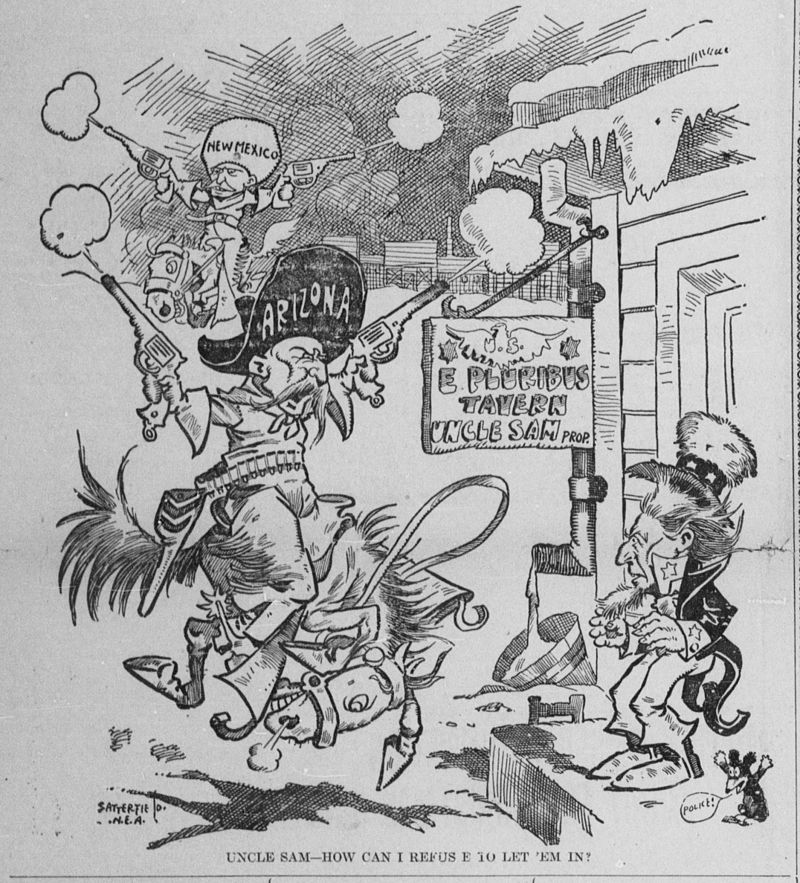
1903 editorial cartoon by Bob Satterfield, depicting
Arizona and New Mexico as crazed gunfighters
intent on gaining access to the
"E pluribus unum tavern". |
The Great Depression
The Great Depression of 1929-39 hit Arizona hard. At first
local, state and private relief efforts focused on charity, especially
by the Community Chest and Organized Charities programs. Federal money
started arriving with the Federal Emergency Relief Committee in 1930. Different
agencies promoted aid to the unemployed, tuberculosis patients, transients,
and illegal immigrants. The money ran out by 1931 or 1932, and conditions
were bad until New Deal relief operations began on a large scale in 1933.
Construction programs were important, especially Hoover Dam (originally
called Boulder Dam), begun by President Herbert Hoover. It is a concrete
arch-gravity dam in the Black Canyon of the Colorado River, on the border
with Nevada. It was constructed by the Federal Bureau of Reclamation between
1931 and 1936. It operationalized a schedule of water use set by the Colorado
River Compact of 1922 that gave Arizona 19% of the river's water, with
25% to Nevada and the rest to California.
World War II
| Construction of military bases in Arizona was a national
priority because of the state's excellent flying weather and clear skies,
large amounts of unoccupied land, good railroads, cheap labor, low taxes,
and its proximity to California's aviation industry. Arizona was attractive
to both the military and private firms and they stayed after the war.
Fort Huachuca became one of the largest nearly-all-black
Army forts, with quarters for 1,300 officers and 24,000 enlisted soldiers.
The 92nd and 93rd Infantry Divisions, composed of African-American troops,
trained there.
During the war Mexican-American community organizations
were very active in patriotic efforts to support American troops abroad,
and made efforts to support the war effort materially and to provide moral
support for the young American men fighting the war, especially the young
Mexican-American men from local communities. Some of the community projects
were cooperative ventures in which members of both the Mexican-American
and Anglo communities participated. Most efforts made in the Mexican-American
community, however, represented localized American home front activities
that were separate from the activities of the Anglo community. Mexican-American
women organized to assist their servicemen and the war effort. An underlying
goal of the Spanish-American Mothers and Wives Association was the reinforcement
of the woman's role in Spanish-Mexican culture. The organization raised
thousands of dollars, wrote letters, and joined in numerous celebrations
of their culture and their support for Mexican-American servicemen. Membership
reached over 300 during the war and eventually ended its existence in 1976. |
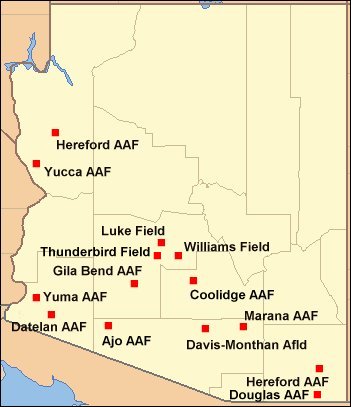
Major airfields in Arizona during World War II. |
Heavy government spending during World War II revitalized
the Arizona economy, which was still based on copper mining, citrus and
cotton crops and cattle ranching, with a growing tourist business.
Military installations peppered the state, such as Davis-Monthan
Field in Tucson, a main training center for air force bomber pilots. Two
relocation camps opened for Japanese and Japanese Americans brought in
from the West Coast.
Historical population
Census Pop. %±
1860 6,482 —
1870 9,658
49.0%
1880 40,440 318.7%
1890 88,243 118.2%
1900 122,931 39.3%
1910 204,354 66.2%
1920 334,162 63.5%
1930 435,573 30.3%
1940 499,261 14.6%
1950 749,587 50.1%
1960 1,302,161 73.7%
1970 1,745,944 34.1%
1980 2,718,215 55.7%
1990 3,665,228 34.8%
2000 5,130,632 40.0%
2010 6,392,017 24.6%
Sources: 1910-2010
After 1945
After World War II the population grew rapidly, increasing
sevenfold between 1950 and 2000, from 700,000 to over 5 million. Most of
the growth was in the Phoenix area, with Tucson a distant second. Urban
growth doomed the state's citrus industry, as the groves were turned into
housing developments. The cost of water made growing cotton less and less
profitable, so the state's production steadily declined. By contrast, manufacturing
employment jumped from 49,000 in 1960 to 183,000 by 1985, with half the
workers in well-paid positions. High-tech firms such as Motorola, Hughes
Aircraft, Goodyear Aircraft, Honeywell, and IBM had offices in the Phoenix
area. By 1959, Hughes Aircraft had built advanced missiles with 5,000 workers
in Tucson.
Political leadership
Despite being a small state, Arizona produced several
national leaders for both the Republican and Democratic parties. Two Republican
Senators were presidential nominees: Barry Goldwater in 1964 and John McCain
in 2008; both carried Arizona but lost the national election. Senator Ernest
McFarland, a Democrat, was the Majority Leader of the U.S. Senate from
1951 to 1952, and Congressman John Rhodes was the Republican Minority Leader
in the House from 1973 to 1981. Democrats Bruce Babbitt (Governor 1978–87)
and Morris Udall (Congressman 1961–90) were contenders for their party's
presidential nominations. In 1981 Sandra Day O'Connor became the first
woman on the U.S. Supreme Court; she served until 2006.
Retirement communities
Warm winters and low cost of living attracted retirees
from the so-called snowbelt, who moved permanently to Arizona after 1945,
bringing their pensions, Social Security, and savings with them. Real estate
entrepreneurs catered to them with new communities with amenities pitched
to older people, and with few facilities for children. Typically they are
gated communities with controlled access and had pools, recreation centers,
and golf courses.
In 1954, two developers bought 320 acres (1.3 km2) of
farmland near Phoenix and opened the nation's first planned community dedicated
exclusively to retirees at Youngtown. In 1960, developer Del Webb, inspired
by the amenities in Florida's trailer parks, added facilities for "active
adults" in his new Sun City planned community near Phoenix. In 1962 Ross
Cortese opened the first of his gated Leisure Worlds. Other developers
copied the popular model, and by 2000 18% of the retirees in the state
lived in such "lifestyle" communities.
Environmental issues
The issues of the fragile natural environment, compounded
by questions of water shortage and distribution, led to numerous debates.
The debate crossed traditional lines, so that the leading conservative,
Senator Barry Goldwater, was also keenly concerned. For example, Goldwater
supported the controversial Colorado River Storage Project (CRSP). He wrote:
I feel very definitely that the [Nixon]
administration is absolutely correct in cracking down on companies and
corporations and municipalities
that continue to pollute the nation's
air and water. While I am a great believer in the free competitive enterprise
system and all that it entails,
I am an even stronger believer in
the right of our people to live in a clean and pollution-free environment.
To this end, it is my belief that
when pollution is found, it should
be halted at the source, even if this requires stringent government action
against important segments
of our national economy.
Water issues were central. Agriculture consumed 89% of
the state's strictly limited water supply, while generating only 3% of
the state's income. The Groundwater Management Act of 1980, sponsored by
Governor Bruce Babbitt, raised the price of water to farmers, while cities
had to reach a "safe yield" so that the groundwater usage did not exceed
natural replenishment. New housing developments had to prove they had enough
water for the next hundred years. Desert foliage suitable for a dry region
soon replaced grass.
Cotton acreage declined dramatically, freeing up land
for suburban sprawl as well as releasing large amounts of water and ending
the need for expensive specialized machinery. Cotton acreage plunged from
120,000 acres in 1997 to only 40,000 acres in 2005, even as the federal
treasury gave the state's farmers over $678 million in cotton subsidies.
Many farmers collect the subsidies but no longer grow cotton. About 80%
of the state's cotton is exported to textile factories in China and (since
the passage of NAFTA) to Mexico.
Recent events
Super Bowl XXX was played in Tempe in 1996 and Super Bowl
XLII was held in Glendale in 2008. Super Bowl XLIX was also held in Glendale
in 2015.
Illegal immigration continued to be a prime concern within
the state, and in April 2010, Arizona SB1070 was passed and signed into
law by Governor Jan Brewer. The measure attracted national attention as
the most thorough anti-illegal immigration measure in decades within the
United States.
On June 30, 2013, nineteen members of the Prescott Fire
Department were killed fighting the Yarnell Hill Fire. The fatalities were
members of the Granite Mountain Hotshots, a hotshot crew, of whom only
one survived as they were working in another location.
In June 2017, a heat wave grounded more than 40 airline
flights of small aircraft, with American Airlines reducing sales on certain
flights to prevent the vehicles from being over the maximum weight permitted
for safe takeoff.
|